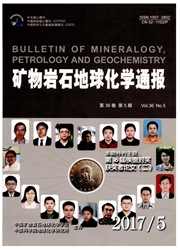

 中文摘要:
中文摘要:
四川攀枝花地区出露有新元古代苦橄质岩脉。本文研究表明这些苦橄质岩脉的铂族元素(PGE)含量较高(19.7~29.0 ng/g),原始地幔标准化后的PGE分布模式呈Pt-Pd富集型,Pd/Ir值(5.64~11.33)与高镁玄武岩和科马提岩相似。同时,这些岩石显示在形成过程中没有经历硫化物和PGE合金矿物的熔离,其原始岩浆起源于地幔较高程度的部分熔融,可能与地幔柱的影响有关。通过扣除铬尖晶石和橄榄石结晶分异对PGE造成的影响,得到原始岩浆的PGE组成特征为Ir、Ru、Rh相对于Pt、Pd明显亏损,在源区已无硫化物存在的条件下,这很可能是由于地幔部分熔融过程中有IPGE合金矿物残留在地幔源区。攀枝花地区苦橄质岩脉可能与该地区冷水箐Cu-Ni硫化物矿床具有相似的原始岩浆组成。
 英文摘要:
英文摘要:
Some Neoproterozoic picritic dykes are exposed in the Panzhihua area of Sichuan province,SW China. In this study,the data of platinum-group elements( PGE) are reported for these picritic dykes. The picritic dykes are characterized by relatively high PGE contents( 19. 7-29. 0 ng/g) and Pt-Pd enrichment in mantle-normalized patterns,with their Pd/Ir ratios ranging from 5. 64 to 11. 33,which are similar to those of the high magnesium basalts and komatiites. In addition,the parental magma of these picritic dykes were S-unsaturated and generated by high degree partial melting of the mantle source,with no sulfide or PGE alloys segregation. To estimate the abundances of PGE in the primary magma,we have adjusted for effects of fractional crystallization of Cr-spinel and olivine phenocrysts in a picritic sample. The obvious depletions of Ir,Ru and Rh relative to Pt and Pd in the primary magma may attribute to the retention of Ir,Ru and Rh by IPGE in their mantle source in which no residual sulfide is existed. The picritic dykes in the Panzhihua area and the Lengshuiqing Cu-Ni sulfide deposit may have similar primary magma in composition.
 同期刊论文项目
同期刊论文项目
 同项目期刊论文
同项目期刊论文
 Platinum-group minerals and tellurides from the PGE-bearing Xinjie layered intrusion in the Emeishan
Platinum-group minerals and tellurides from the PGE-bearing Xinjie layered intrusion in the Emeishan SHRIMP Zircon U-Pb geochronology, elemental, and Nd isotopic geochemistry of the Neoproterozoic mafi
SHRIMP Zircon U-Pb geochronology, elemental, and Nd isotopic geochemistry of the Neoproterozoic mafi 期刊信息
期刊信息
